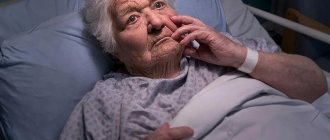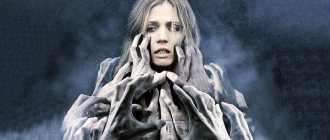Symptoms of a mental disorder
The World Health Organization divides the symptoms of mental disorders in humans into 4 main groups:
- Sensory-perceptual symptoms in which a person has a distortion of reality and can hear, feel or see things that others cannot sense.
- A common neurological symptom is cognitive impairment. The patient is increasingly experiencing a disorder of clear speech, memory lapses occur, and pathological beliefs about an event are established.
- Symptoms of a behavioral nature, when the patient may show unreasonable aggression towards relatives or stop performing daily functions.
- Emotional disorders most often occur as the main symptom; the patient may constantly feel a feeling of fear or sadness.
A very important legal digression
regarding who and where can hospitalize us without our consent. This refers, of course, to a psychiatric hospital (“...orderlies will come and take away without consent...”)
So:
- The orderlies won't take it away. Hospitalization in a psychiatric hospital without the consent of the patient is possible only in the presence of a mental disorder (establishing a diagnosis and making a decision to provide psychiatric care in an involuntary manner is the exclusive right of a psychiatrist or a commission of psychiatrists) ((Article 20 Part 2 of Federal Law N 3185-I “On psychiatric care and guarantees of the rights of citizens during its provision” dated July 2, 1992)
- That is, without consent, they can “take away” by decision of a doctor , or by order of a judge ((Article 28 Part 1 of Federal Law No. 3185-I “On psychiatric care and guarantees of the rights of citizens during its provision” of July 2, 1992), but This is not the only important thing.
- According to the law, a psychiatrist is a psychiatrist (he will arrive as part of an ambulance if the patient is rowdy), who can easily place in a hospital with one of his decisions (note! Until the court’s decision! with one of his decisions! Yes, according to the law he can!) someone who is with him point of view is sick (the doctor will talk with the patient and make a decision right on the spot - see “psychiatric examination”), this same doctor, by law, cannot begin an examination (conduct an examination) without the sanction of a judge , if the supposedly sick person does not agree to this . (Article 23 Part 2 of Federal Law No. 3185-I “On psychiatric care and guarantees of the rights of citizens during its provision” dated July 2, 1992)
- And the law (!) removes this restriction (!) on conducting an examination without the patient’s consent in several cases.
○ if the patient is under 15 years old . In this case, consent can be given by one of the parents, a guardian, or a guardianship authority (Article 23, Part 1 of Federal Law No. 3185-I “On psychiatric care and guarantees of the rights of citizens during its provision” of July 2, 1992)
○ if the patient is already under the supervision of psychiatrists in a dispensary (Article 23, Part 5 of Federal Law N 3185-I “On psychiatric care and guarantees of the rights of citizens during its provision” of July 2, 1992)
○ if the doctor decides during the examination that the patient’s mental disorder is severe, and his behavior causes an immediate danger to himself or others (there will be a trial, but in the hospital) (Article 24 of the Federal Law No. 3185-I “On psychiatric care and guarantees of the rights of citizens upon its provision” dated July 2, 1992)
○ if the patient is recognized as legally incompetent and, due to his condition, cannot give informed consent. The fact is that without it, such consent can be given by his legal representative (guardian), or the guardianship and trusteeship authority (Article 23, Part 1 of Federal Law N 3185-I “On psychiatric care and guarantees of the rights of citizens during its provision” of July 2 1992)
○ if the psychiatrist has a court sanction (decree) to conduct a psychiatric examination on an involuntary basis. By the way, the actions of the judge can be appealed to the court in the manner established by the legislation of the Russian Federation (Article 24, 25 of the Federal Law N 3185-I “On psychiatric care and guarantees of the rights of citizens during its provision” dated July 2, 1992)
○ if a sick or supposedly sick person is in unfavorable living conditions (lack of observation, care for the patient, being away from the family, on the street, etc.) and his “severe mental disorder” meets any of three criteria:
■ immediate danger to yourself or others
■ helplessness, that is, the inability to independently satisfy basic life needs
■ significant harm to his health due to a deterioration in his mental state if the person is left without psychiatric help. (Order of the Russian Ministry of Health N 108 “On emergency psychiatric care” dated April 8, 1998)
That is, an examination by a psychiatrist of a supposedly mentally ill person will be carried out either voluntarily - if the patient gives written informed consent to its conduct, or - involuntarily (that is, without the consent of this person or his legal representative) - if he himself gives for this grounds (usually this is inadequate plus, as an option, aggressive, self-aggressive or threatening behavior during the previous 24 hours). Therefore, you need to do your best to talk calmly with the person, and in the conversation show him that his health is currently unstable and may require medical attention.
You can also try making an appointment with a specialist at home. However, it should be remembered that if the patient categorically disagrees with outside intervention, persistent imposition of medical care on him can provoke fear and panic; feelings that someone or something is trying to take over his body, life, property, maybe even kill him; that is, his condition may worsen. The patient will withdraw into himself, lose trust in others, stop accepting help from them, and possibly accuse them of organizing his persecution or murder; the matter may end in severe aggression or auto-aggression, escape, or a suicide attempt. In this case, providing assistance to the patient will become much more difficult, and the risks for the patient and doctors will increase many times over.
If the patient’s behavior is inappropriate and unpredictable, and the condition is definitely acute; especially if it is accompanied by attempts to harm oneself or others, an emergency psychiatric team and the police should be immediately called to hospitalize the patient involuntarily.
All materials on the site are presented for informational purposes only, approved by certified physician Mikhail Vasiliev, diploma series 064834, in accordance with license No. LO-77-005297 dated September 17, 2012, by a certified specialist in the field of psychiatry, certificate number 0177241425770.
Signs of a mental disorder
Every second person with a mental disorder, starting from the early stages of the disease, experiences characteristic symptoms. They can appear with different intensities and frequency, but they are easy to notice with constant observation of a person. If one of the signs appears, you cannot leave it unnoticed and you should seek professional help.
Signs of a mental disorder most often go beyond certain cultural norms or beliefs in modern society. It is customary to identify the main signs of the course of the disease, which are most common among people with this diagnosis - memory impairment and sound thinking, sudden changes in a person’s behavior and mood for no known reason.
Cotard's syndrome
One of the striking characteristics of this syndrome is delusions of grandeur turned inside out: a person believes that he or certain parts and organs of his body have already died, rotted, decomposed, or are simply missing.
Still from the film "Pirates of the Caribbean: Dead Men Tell No Tales"
A person with Cotard's syndrome is often convinced that he is causing catastrophic harm to humanity: that he has infected everyone with a terrible infection, poisoned or completely wiped out humanity from the face of the earth, that because of his putrefactive breath the planet will soon die out.
Reminds me of some of the characters from Pirates of the Caribbean, doesn't it?
Causes of mental disorders
Scientists have found that the reasons for changes in a person’s mental state can be external factors such as psychological or social. Biological factors include a genetic predisposition to constant depression or nervous breakdowns, especially if, while a person was growing up, there were complex relationships between parents that left a certain imprint on the child’s psyche.
The results of many years of research have shown that the causes of mental disorders most often come from the patient’s unfavorable childhood. Drugs and alcoholism, temporary restriction of a person’s freedom in a confined space, frequent depression, difficult life situations and incidents can also lead to the development of the disease.
Types of mental disorders
Currently, the most common diseases include some types of human mental disorders. These data can always be tracked in the reports of the World Health Organization, where schizophrenia is among the top five most common diseases among the entire world population. It can originate during early human development, but in the transition period its signs will begin to increase.
In second place in popularity are types of disorders associated with the abolition of dependence on psychotropic or narcotic substances, including alcohol. Depression, as a type of mental disorder, occurs in every fifth inhabitant of the planet and is accompanied by pessimistic views of life and an apathetic mood.
Psychological mental disorders
According to the International Classification of Diseases, psychological mental disorders belong to groups F10 – F19 and are associated with human behavior disorder due to excessive use of psychoactive substances.
Most often, this type of disorder occurs against the background of addiction to a certain type of psychotropic drug. A person is convinced on a subconscious level that it is psychotropic substances that give him a dose of pleasure and without them he cannot exist normally. Over time, addiction occurs, which cannot be eliminated without professional help and treatment.
PsyAndNeuro.ru
In demographic and health studies, the division of the “elderly” age group into subgroups is sometimes used. Typically, the boundaries of the subgroups look like this: “young old” – 60-74 years old, “old old” – 75-85 years old, “oldest old” – over 85 years old.
The prevalence of depression in the 85+ age group ranges from 5 to 32%. The risk is increased by living alone, medical illnesses, functional decline and cognitive impairment. In general, depression in this age group manifests itself in the same way as in other age groups. But there are some clinical features that are characteristic of the 85+ group, which include an increased likelihood of subthreshold symptoms, “depression without sadness,” concern about physical health, unexplained somatic symptoms and apathy.
Bipolar disorder is uncommon in older people. In the 65+ group, the prevalence is 0.1-0.5% (in young people 1.4%). Many cases are a relapse of an early illness, diagnosed bipolar disorder or recurrent depression, which for the first time in life gave way to mania. Pathological mood elevation, which first appears in old age, is associated with various medical, cardiovascular and cognitive factors. In general, the clinical manifestations of mania are the same at all ages, but in older adults, mania is less intense and symptoms are more likely to persist for a longer period of time. Symptoms of mania last for at least a week, causing significant functional impairment, and are sometimes so severe that psychosis (delusions of grandeur, paranoid delusions, and thought disorder) sets in. At least one episode of mania in a lifetime is enough to make a diagnosis of bipolar I disorder. With hypomania, symptoms may last less (4 days) and are usually less severe (without loss of function). Hypomania can occur in bipolar I disorder (if there was a history of mania), but if there was a history of major depressive disorder, a diagnosis of bipolar II disorder can be made.
The prevalence of anxiety disorders in the elderly is 15%, and certain symptoms are even more common. Anxiety disorders almost always begin at a younger age, relapses are followed by remission, the onset of symptoms is tied to life stress, and relapse in old age often occurs due to the fact that the usual coping strategies cease to work. Risk factors: female gender, absence of a spouse, multiple comorbid conditions (including vascular diseases), certain character traits (neuroticism and perfectionism). Only a minority develop anxiety disorders in old age. This may occur in the context of an adjustment disorder or in association with cognitive decline or physical illness. Particularly severe agitation and dysphoria may indicate anxiety secondary to depression, although depression and anxiety may coexist in the oldest old.
GAD is most common in older people. Comorbid mental disorders (especially depression), as well as the appearance of GAD against the background of certain somatic diseases (for example, stroke or Parkinson's disease), are very typical.
Phobias are also common. More often than in young people, specific phobias associated with the natural environment (lightning, heights) occur. Also common (60% in some samples) is phobia of falls, a condition that occurs after the experience of falling or due to problems with balance. Agoraphobia can develop as a result of fear of falling, awkward situations (for example due to incontinence), panic attacks in a public place.
Panic disorder, OCD, and PTSD are much less common and are usually associated with physical illness or cognitive decline. There are studies showing that older people with OCD are more likely than younger people to develop obsessions related to the idea of sin, compulsive hand washing, and pathological hoarding. Trauma in old age (falls, cancer risk, bereavement, frightening experiences of delirium) can cause anxiety similar to PTSD symptoms, and in addition, physical, cognitive and psychosocial stress can activate PTSD associated with youth trauma (including experiences in school and the military ).
Psychosis is quite common in the elderly. Usually these are secondary psychoses, but there are also primary ones. According to DSM-5, secondary psychotic syndromes in the elderly include delirium, dementia, and mood disorders. Primary psychotic syndromes include delusional disorder, schizophrenia, and schizoaffective disorder. Symptoms overlap regardless of the cause of psychosis, but often the outlines of the disease are obvious and indicate a likely etiology.
Primary psychotic illnesses with onset in youth progress differently and can continue into old age. Many years of use of antipsychotics or mood stabilizers result in extrapyramidal side effects, tardive dyskinesia, metabolic or renal dysfunction, and electrolyte imbalances.
Primary psychotic conditions can also occur in old age. This happens more often in women. More likely to occur in groups that are marginalized, discriminated against, or have difficulty communicating socially, such as migrants and people with hearing or vision impairments. From a clinical perspective, they may meet traditional diagnostic criteria for schizophrenia or delusional disorder, or fall somewhere “in between” these diagnoses. Such cases are referred to as paraphrenia, late (after 40 years of age) schizophrenia, or very late onset (after 60 years of age) schizophrenia-like psychosis, reflecting the lack of clear definitions, classification and phenomenology in studies of this very heterogeneous group of patients. Most experience delusions of persecution, often in the form of ideas about being observed or influenced through walls, floors, or ceilings, directly or through gas, radiation, or electricity. Auditory hallucinations are common. Formal thought disorder is rare, and the affective state usually does not change. Mild cognitive deficits may occur.
Men commit suicide much more often, with age peaks occurring in middle age and at age 85+. An important risk factor is depression, especially with comorbid anxiety, and in a large number of cases depression remains undiagnosed until a suicide attempt.
(The author of the article refers to Australian statistics from 2015 showing an increase in the likelihood of suicide in men in the age groups 45-49 and 85+. The age profile of suicide mortality in Russia (2010-2014) is slightly different: for men the peaks are at 30 -34 and 80+, for women 85+.)
The likelihood of suicide increases with the presence of somatic diseases (especially cancer and cardiovascular diseases), disability, social isolation and personality traits such as introversion, anxiety, and obsession. Most often, the reasons are traumatic losses, loneliness, extremely severe anxiety, loss of independence, and a feeling of hopelessness.
Key Points in a Psychiatric Examination
- It is necessary to collect information from close people (relatives, friends, social workers), especially if there is cognitive impairment that makes it difficult to describe symptoms. In addition to facilitating diagnosis, it provides valuable data about the patient's premorbid personality, functionality, and the nature of his social relationships.
- It is necessary to assess risks of all types:
– Risk to the patient (self-harm, accident, self-neglect);
– Risk to reputation and financial well-being;
– Risk from others (ignoring the patient’s needs or intentionally causing harm);
– Risk to other people (aggressive behavior or disregard for the safety of others);
The nature and severity of these risks will determine the choice of treatment strategy.
- It is necessary to find out whether the observed condition is the debut of a mental illness or is it a relapse of a recurrent disease. It is necessary to understand the risk factors and possible causes (family history, cardiovascular factors, relevant medical diseases, use of drugs that affect the mental state).
- It is important to remember that in this age group, depression and anxiety often manifest subsyndromal or somatic forms.
- You should always ask about substance use. It's easy to miss important things like alcohol or drug abuse (especially benzodiazepines and opiates) and excessive caffeine consumption.
- Cognitive abilities should always be assessed.
For some types of disorders, non-pharmacological treatment may be sufficient. The best studied method is cognitive behavioral therapy. There is ample evidence of its effectiveness for insomnia, chronic pain, substance abuse, depression, delusional disorders, hallucinations and some types of psychosis, and especially anxiety disorders - but there is insufficient evidence of effectiveness in the 85+ age group.
The medications and neurostimulation methods used are generally no different from those used in other age groups. Despite the risk of side effects, antidepressants, antipsychotics and sedatives are prescribed particularly frequently in the “oldest elderly” group. As with all age groups, the first step should be to obtain informed consent from the patient.
The choice of antidepressant is influenced by its tolerability. There are studies showing that the effectiveness of antidepressants is reduced in depression that begins in old age against the background of vascular pathologies and dementia.
SSRIs are the first-line drugs of choice. Alternative antidepressants include SSRIs (especially in cases of severe depression or in the presence of comorbid neuropathic pain), tetracyclic antidepressants, agomelatine or SNRIs.
The first signs of improvement appear after a couple of weeks, but the therapeutic effect in the elderly sometimes has to wait longer than usual (10-12 weeks); It is important not to change treatment ahead of time, but to continue the course. If the drug is poorly tolerated or has no effect, you can change the dose or switch to a different class of antidepressant. You can then consider switching to second or third line antidepressants, as well as augmentation with another type of drug (lithium, atypical antipsychotic, thyroxine).
ECT has a good antidepressant effect with a remission rate of 60-90%. If the patient tolerates general anesthesia and the cardiovascular effects of ECT (abrupt changes in heart rate and blood pressure), and has no contraindications (recent heart attack or stroke, increased intracranial pressure or mass formations in the skull, retinal detachment), then ECT can be safely used in the 85+ group. Side effects are usually minor (headache, nausea), the main potential problem is related to cognitive impairment (confusion, anterograde and retrograde amnesia, deterioration of executive functions); In most cases, this resolves over time, but in some patients, cognitive problems may persist for a long time.
For mania, any mood-elevating drug should be discontinued and replaced with a mood stabilizer.
First-line drugs for anxiety are SSRIs and SSRIs. Patients with anxiety are often wary of their physical health and may mistake anxiety symptoms for medication side effects; in such cases, an explanation of the situation is required in order to avoid premature discontinuation of the drug and unnecessary repetition of the course. Sometimes a low dose anxiolytic (such drugs may include atypical antipsychotics and pregabalin) is added to control symptoms before the antidepressant takes effect. Benzodiazepines should be avoided if possible or used in low doses only for short periods of time.
The use of antipsychotics in the treatment of elderly patients is associated with a high risk of side effects. As always, this risk must be weighed against the risk of untreated symptoms by assessing the likelihood that antipsychotics will improve the patient's condition. In dementia, one should always focus on non-pharmacological interventions first, reserving antipsychotics for the most persistent psychotic symptoms associated with distress and behavior problems. Late-onset schizophrenia responds to treatment at doses lower than those used for early-onset schizophrenia.
The use of atypical antipsychotics is preferable because their side effects are better tolerated. However, they also have side effects. In some groups (patients with dementia), the risk of death (especially due to pneumonia and heart problems) and the development of physical diseases (including cardiovascular disease) is increased. Apart from clozapine, which is rarely prescribed to the elderly, quetiapine has the lowest likelihood of extrapyramidal side effects. Aripiprazole has fewer metabolic side effects and risperidone has fewer anticholinergic effects. Oral administration is preferred, but in case of poor compliance, injections can be used.
– Mental illness in the elderly may be a relapse of an illness that began long ago, or it may be the debut of a late-onset condition.
– Very often in the “oldest elderly” group, the basis of psychological problems is somatic diseases.
– Depression in the elderly often manifests subsyndromal or in the form of somatic symptoms.
– Treatment is the same as in other age groups, but should start with low doses, increasing slowly if necessary.
– Antidepressants and antipsychotics have significant side effects, but the benefits of taking them may outweigh the risk of side effects.
– ECT is an effective treatment for melancholic or psychotic depression and can be safely used in the treatment of elderly patients.
– For dementia, we need to start with non-pharmacological treatment strategies.
– Older men are at high risk of suicide, so assessing suicide risk is an important part of the assessment.
Author of the translation: Filippov D.S.
Source: Cullen P. (2019) Mental Illness in the Oldest-Old. In: Nagaratnam N, Nagaratnam K, Cheuk G (eds) Advanced Age Geriatric Care. Springer, Cham
Organic mental disorder
Organic and symptomatic disorders manifest themselves in patients at the cerebral level; they can manifest themselves against the background of brain injuries, after a severe stroke, or against the background of abuse of alcohol, narcotic and psychotropic substances.
Organic mental disorder can be diagnosed based on two main characteristics. The first include cognitive dysfunction, when a person has problems with memory or habitual learning. Impairments may be associated with loss of alertness, concentration and awareness. The second group includes vivid manifestations of hallucinations, anxiety and depression, as well as disturbances in emotional behavior.
Acute mental disorders
Transient and acute psychotic personality disorders are characterized by the most rapid development of diseases. The condition of a sick person can deteriorate significantly in just a few days, with several main signs observed - depression and passive mood, accompanied by intense hallucinations, states of seizures and delirium.
Acute mental disorders are conventionally divided into two categories - polymorphic state and schizophrenia. The latter occurs most often, the true causes of which have not yet been established. The risk group may include people who have been subjected to severe violence (not necessarily of an intimate nature), as well as those who have experienced severe emotional stress.
Prerequisites for the development of schizophrenia in childhood
The psyche of a small child is very vulnerable; his condition and mood largely depend on the people around him and the events taking place around him. The psychological perception of reality is established at an early age. If a deviation of the schizoid type is observed, doctors do not undertake to make a definitive diagnosis; they recommend waiting until adolescence.
The tendency to the disease in preschool age manifests itself specifically:
- the child is considered strange - he reacts inappropriately to events;
- often experiences unreasonable fear;
- becomes overly irritable and impulsive;
- when observing him, increased nervous excitability appears;
- bouts of crying that occur for no particular reason can last a long time;
- the child often moves from euphoria to apathy;
- he talks about his visions, hallucinations;
- the teenager is bothered by obsessive thoughts, he gets fixated on the same idea.
If there are several such negative manifestations, there is reason to think about visiting a psychiatrist. Deviations may be accompanied by personality degradation, which will fully manifest itself in adolescence. This may include dissatisfaction with appearance, delusions and hallucinations, motor dysfunction, suicidal thoughts and attempts to die.
Chronic mental disorder
In medicine, chronic disorders are usually understood as a condition of a sick person when it occurs over a long period of time and with characteristic attacks. Types of such disorders include paranoia, epilepsy, manic or depressive psychosis.
Chronic mental disorder, like most diseases of this type, is characterized by periods of improvement and sharp deterioration in a person’s condition. Even after all signs of the disease have been suppressed, the patient is left with a persistent mental defect that is difficult to treat.
How to Reliably Identify Borderline Personality Disorder (BPD)
Borderline personality disorder is extremely difficult to diagnose and differentiate, as it has a high level of comorbidity, in other words, it is combined with a large number of concomitant disorders. For example, panic anxiety, eating disorder, bipolar affective disorder, attention deficit disorder, sociopathy, and so on. Due to the above, the patient has to undergo a lengthy diagnostic process and special tests.
Test for borderline personality disorder BPD
One of the fairly popular tools for identifying the presence of psychopathy are tests, which are essentially a personality questionnaire. The test used in modern clinical psychology to screen for strong signs of BPD was developed in 2012 by a group of scientists. In their work, the authors relied on the basic criteria for differentiating borderline disorder.
The questionnaire edited by them is a fairly effective tool for diagnostic verification and confirmation of symptoms. It is used both in psychiatric and general clinical settings, as well as in other practices that are not directly related to medicine.
The test itself consists of 20 questions and asks the test taker to answer only yes or no. For each answer, the system counts a certain number of points. The likelihood of diagnosing BPD appears if the respondent scores more than 25 points.
Temporary mental disorder
Unlike a chronic disorder, a temporary one involves understanding such conditions of a sick person in which short-term mental abnormalities are observed, ultimately amenable to complete recovery.
A temporary mental disorder can manifest itself in a person in the form of delirium tremens. This pathological condition is most often caused by prolonged alcohol consumption. Temporary disorders also include severe mental states, experiences and nervous conditions caused by external environmental factors.
When is it better to play it safe?
On January 22, a student at the Bauman Moscow State Technical University, Artem Iskhakov, killed his roommate, a student at the Higher School of Economics, Tatyana Strakhova, and violated the corpse. It is known that the guy went to consultations with a psychotherapist and took recommended medications. Could this have been prevented? How can one generally distinguish mental illness from fatigue, stress, or character traits?
– There are no absolutely healthy people. Every person, finding himself in a difficult life situation, often finds himself “on the brink”.
Many experience severe mental suffering and grief after the death of a loved one. Some students experience destructive anxiety, panic disorder, and “bear sickness” before an exam.
A balanced person can burst into “fierce rage” if he is unfairly laid off at work. Unrequited love can plunge a healthy person into prolonged melancholy and melancholy.
We need to sound the alarm:
– if a mood different from the one in which the person was most of his life lasts more than a week. This could be, for example, prolonged gloomy irritability (dysphoria), melancholy, anxiety, or, on the contrary, euphoric excitement without a reason, which may turn out to be a manic syndrome.
– if a person’s condition has lost connection with the cause that caused it. For example, a teenager experienced unhappy love and was moping. Then he forgot about the girl he broke up with, but the blues remained.
– if a person is constantly thinking about the meaning of life, not in a philosophical, but in a practical way: “What will happen after my death? How nice it would be to die quickly and painlessly..."
At the same time, we must keep in mind: genuine suicidality sometimes manifests itself gradually, at first glance as demonstrative and blackmailing self-harm: scratches, abrasions, pinches, burns, self-cuts...
– Self-cutting – is this some kind of fashion?
– Yes, now various types of body art are fashionable among young people: tattoos, piercings, tunnels, self-harm... The latter is when a person, as if inadvertently, shows cuts and scars on the wrists and other open parts of the body.
But sometimes self-harm can also be a symptom of mental illness.
In these cases, every self-harm becomes a therapeutic manipulation. Physical pain, which is much easier, competitively displaces unbearable mental pain.
– How to distinguish fashion from manifestations of illness?
– The severity of hidden painful mental suffering can be so high that minimal mental distress is enough to break through. Therefore, in cases of illness, self-harm occurs not in the calm and prosperous atmosphere of a relaxed get-together, but directly after some kind of conflict.
For example, with teenagers who often do not know how to fully express their feelings, what usually happens is: “We need to do our homework!” It’s difficult to do them when you’re depressed; it doesn’t work. Painful, fruitless sitting until late at night, pressure from parents, the Unified State Exam on the nose.
Hysterics and screams: “I won’t go to school tomorrow!” The teenager then runs to his room in tears, grabs a knife and impulsively cuts himself.
For a while he feels better, he calms down and goes to bed. These are not whims or weak-willed weakness of character!! This is a direct reason to see a doctor. Pathological self-harm, unlike fashion, is not demonstrated, but hidden. Self-cuts are applied in invisible places (thighs, stomach...)
Treatment of mental disorders
To treat a mental disorder or reduce a person’s suffering during an exacerbation of the disease in modern medicine, there are effective methods that can be practically successfully used only with professional supervision or while in an inpatient hospital.
Treatment of mental disorders should only take place in combination with the use of psychotropic medications and professional psychotherapy. For patients, the use of pills alone is not enough; it is important to regularly conduct conversations or exercises to get rid of the symptoms and causes of a serious mental illness.
The new generation of antipsychotics is not addictive
- Fine. The patient went to the doctor or stayed in the hospital, but does not want to take pills. What is the most common explanation for refusal?
– Very often the reason for refusal is not the disease itself, but a deformed public opinion about psychiatry and psychotropic treatment (stigma), filled with many archaic myths and ridiculous horror stories. The two most common myths regarding psychotropic medications are that they can make you “become a vegetable” and that these drugs are addictive.
In fact, there is no dependence and no “vegetable” conditions from modern psychotropic drugs.
New generations of antipsychotics and antidepressants do not at all make a person lethargic and thoughtless, stupid and ridiculously funny. Moreover, the latest generation of antipsychotics are precisely drugs aimed at activating, rather than inhibiting, the psyche. Since most patients with mental disorders, including the schizophrenia spectrum, have problems with volitional functions, these people need activation.
The course of modern antidepressants is strictly limited in time and, as the patient recovers from depression, under the supervision of a psychiatrist, they are successfully discontinued. You need to understand that antidepressants do not simulate a psychotropic good mood, but remove the disease and return a person to his natural feelings and emotions.
– Can these good new drugs be obtained through compulsory medical insurance?
- Certainly!
Most of them in original or generic versions are included in the free drug supply lists. Patients under observation in a government institution (for example, a dispensary) receive these drugs free of charge. And going to the dispensary today is not the end of life. There has been no accounting for a long time. And if the patient is sufficiently stable, he has no fundamental life restrictions (car license, work, etc.) in connection with advisory observation at the dispensary. “Neurosis Clinic” named after Solovyov on Shabolovka and a psychotherapeutic clinic attached to it on Mira Avenue , where there is an inpatient department, an outpatient department and a day hospital (all included in compulsory medical insurance). Free consultative and diagnostic assistance to children and adolescents is provided at the Scientific and Practical Center for Mental Health of Children and Adolescents named after Sukhareva (part of the compulsory medical insurance). It is also important that on the sick leave certificate or student/school certificate, which, if necessary, is issued by each such institution, they no longer write the diagnosis and do not indicate the name of the medical institution where the patient was treated. No one has canceled medical confidentiality!
Treatment of mental disorders in men
Among men, acute and organic types of mental disorders are most common, which require a more serious and long-term approach to treatment. Psychosis, schizophrenia, addiction to illegal drugs and manic episodes – these diseases affect more than 40% of the male population. According to WHO statistics, men are much less likely to admit that they have mental disorders than women.
Treatment of mental disorders in men occurs under constant supervision by a professional psychotherapist. The most effective treatment is achieved only if it is comprehensive, that is, a combination of medications with techniques and exercises that are based on a direct conversation between the patient and the doctor.
Treatment of mental disorders in women
Most often, women experience mental disorders associated with depression or constant anxiety. These species are the most resistant to drug treatment. Any treatment is based only on an individual approach, based on the woman’s condition, her age and previous injuries to the disease.
Treatment of mental disorders in women is based on a specific scheme, which includes the use of antidepressants, a combination of other pharmacological agents and mandatory psychotherapeutic techniques.
Mental disorders in adolescents
One in six people affected by a mental disorder are in the 10-19 age group, one of the most difficult transition periods of adulthood. The main reason for the mental disorder of a teenager is the process of personality formation, which can be negatively influenced by the people around him, as well as a manic desire to try prohibitive drugs for the first time in his life.
Mental disorders in adolescents can only be treated in a comprehensive manner by professionals together with parents. During this period, it is important to create a safe atmosphere for the life of a teenager, to protect him from possible risks and negative factors from others.
Schizophrenia and menopause
The level of hormones in the female body can manifest a mental disorder - because of this, the disease often begins in puberty (hormonal changes in adolescents), during pregnancy and after childbirth, and can begin in perimenopause (before and after menopause).
A woman who experiences hormonal involution (hormone production decreases, menstrual function disappears) experiences anxiety, irritability, and vegetative symptoms that dramatically affect her well-being.
Important
Only if real problems are observed - depression, strange ideas (they allegedly threaten a woman, want to rob her, conduct experiments on her), “obsession” with health, inappropriate behavior, should you consult a psychiatrist.
Neuroses (neurasthenia, generalized anxiety disorder), affective disorders (depression), and schizophrenia of various courses can be hidden behind similar symptoms. An accurate diagnosis requires consultation with a psychiatrist and modern instrumental and laboratory diagnostics.
Mental disorders in children
Mental disorders in children under 10 years of age may be indicated by symptoms such as impaired attention and hyperreactivity, which manifests itself in the form of extreme mobility or fussiness. Starting from the very birth of a child, it is very important not to miss the moment of the onset of pathological deviations in his behavior.
The doctor is faced with the task of promptly and correctly dividing mental disorders due to improper pedagogical upbringing of parents or genetic predisposition. The initial signs of the disease in children include decreased appetite, which occurs repeatedly in the form of vomiting or complete refusal to eat.











